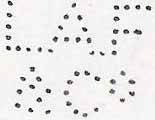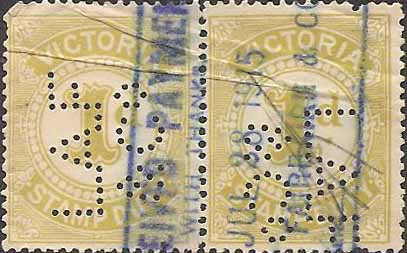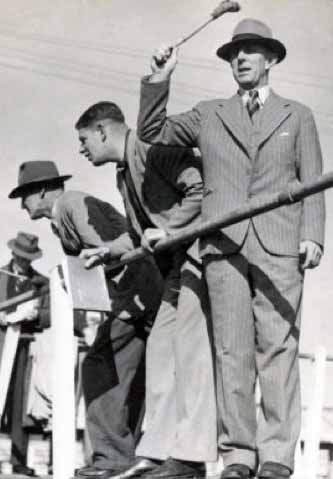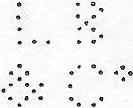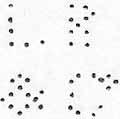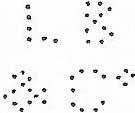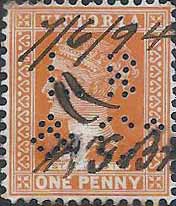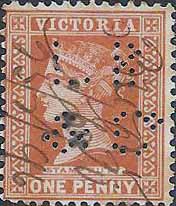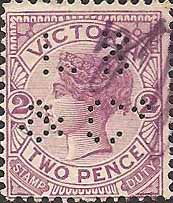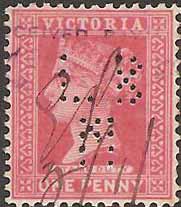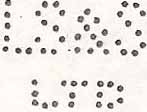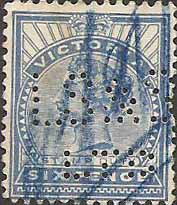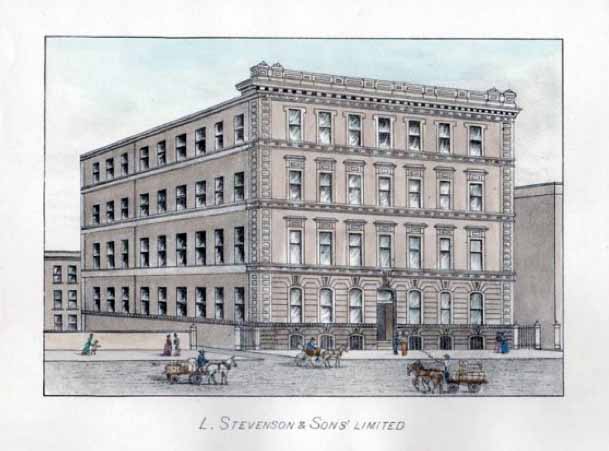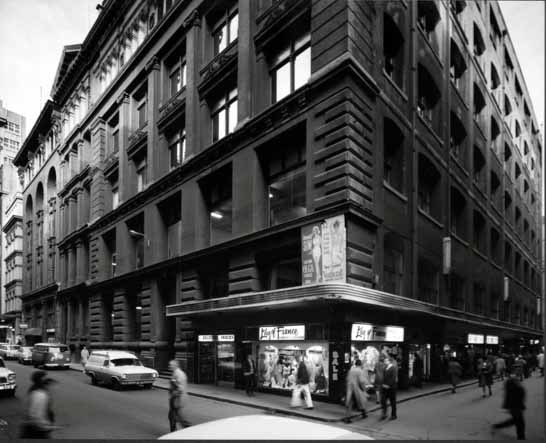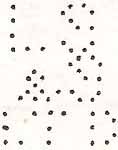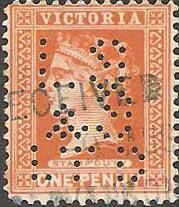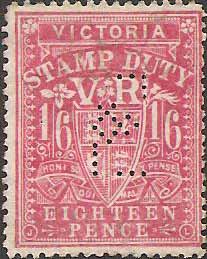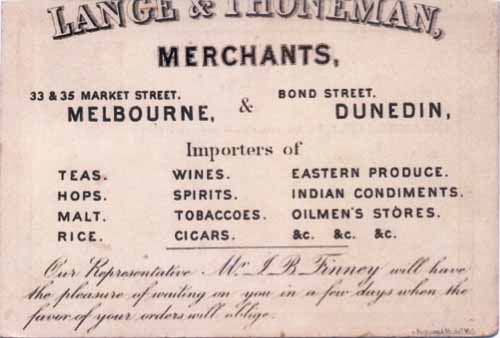|
Private Revenue Perfins of Victoria An Elsmore Coath production The authors would welcome your comments additions or input into this work A B C D E F G H I J K L M N O P Q R S T V W Y Other L -------------------------------------------------------- L.A.F/&Co.a
User: L A Fairbairn & Co Stock & Station Agents Address: 94-96 King St, Melbourne, VIC Later (Circa 1914) St James Building, 117 William St, Melbourne, VIC Also Newmarket, Ballan & Bacchus, VIC Revenue Use: 1911 Series 1d Rarity Scale:
1911 Series 1d R4
Background: *The company of L A Fairbairn & Co was started by L (Lachlan) A (Alexander) Fairburn and his brother Robert in the late 1890’s. Lachlan was born in 1862 one of 11 children born to Thomas Fairbairn. Thomas had emigrated from Scotland and married in 1855, before moving to Pentland Hills (west of Bacchus Marsh, Victoria) were he worked as a sheep farmer.
At the age of 13, Lachlan, along with his younger brother Robert (11) started moving mobs of sheep between local farms and the sale yards in Newmarket, Melbourne. Then as a 17 year old Lachlan, again with Robert, moved a mob of 10,000 sheep from Cobar (NSW) to Euston on the Murray. Later the pair worked as station hands for 2 ½ years before returning home.
Lachlan, with the small amount of money he had saved, leased properties and stocked them and then sold the stock at market for profit. In the early 1880’s he spent a year with Stock and Station agents King and Cunningham before returning to grazing.
In 1891 he purchased his first property at Ballan and with brother Robert; he started a Stock Auction business, also at Ballan. By 1907 they had expanded the operations of L A Fairbairn & Co to Melbourne, Bacchus Marsh and Ballan.
The company was successful and Lachlan started to acquire large tracks of land in Melbourne’s West, particularly in Essendon as well as Stations in both Victoria and NSW.
Lachlan retired in 1915 and spent much of his time at his large home at “Ardoch Towers” in Essendon. The business continued to trade and was managed by Lachlan’s brothers Robert (died 1924), Thomas and Lachlan’s sons Roy and Gordon.
Lachlan had married in 1889 to Jean McQualter and they had 7 children but 3 died as infants. Lachlan died in October 1918 aged just 56. The sons Roy and Gordon continued in the business and it remained a family affair with cousins, and second cousins active in the company. Lockie, Gordon and Donald Fairbairn at Flemington Saleyards, Melbourne, (Circa 1950) all descendants of Thomas Fairbairn of L.A. Fairbairn & Co. Stock & Station Agents
Gordon & Donald Fairburn were bought out by Younghusband Ltd in January 1954 but the company still traded under the name of L A Fairburn Stock and Station agents into the 1960’s.
Notably Younghusband Ltd were also perfin users but these patterns are not reported on revenue stamps.
Device: The LAF/&Co.a device was a Single Die device that came into service in about 1914. It was a sound device that generally produced complete strikes, but it started to lose pins in the late 1920’s and after that the pattern was at sometimes rather indistinct. This loss of pins continued into the 1930’s and this likely lead to reports in other studies of a pattern IAF. See the I section of the NSW Chapter because this IAF pattern has been previously reported to have been found on the revenue stamps of NSW.
These reports are incorrect as there is no IAF device used in Australia and the LAF/&Co.a device was only used in Melbourne over its life.
In previous studies of Australian Private perfins the user of the LAF/&CO.a device is not reported and nor is it reported to be found on the revenue stamps of Victoria. This is understandable as revenue use is rare.
The LAF/&Co.a pattern is found on both the revenue stamps of Victoria and the postage stamps of Australia. Usage is only during the period 1914-1938, and when the device was discontinued it was not replaced.
Related Patterns: Nil
* Trove, Clare County Library. -------------------------------------------------------- LB/&Co.a
User: Levy Bros Importers & Commission Agents Address: Queens Arcade (271-273 Lonsdale St-Little Bourke St)
Later (Circa 1858) 24 Bourke St East
Other locations see Background below.
Later (Circa 1890) Queens Arcade, Lonsdale St, Melbourne, VIC Revenue Use: 1886-1899 Series, inscribed 'STAMP DUTY' 1d (shades), 2d, 6d Rarity Scale:
1886-1899 Series 1d R4, 2d R4, 6d Background: *In 1852 the Levy brothers, Goodman, Nathaniel and Lewis, established a fancy goods warehouse and importing business in Lonsdale Street, Melbourne. Another brother, Alfred, was a travelling sales representative. When Queen's Arcade (the first arcade in Melbourne) was completed in 1853, they took one of the corner shops, soon adding another five or six shops as the business expanded. In 1857 the brothers advertised in the front of the Sands and Kenny Melbourne Directory, showing their addresses as: 37, 38, 39, 40, 41, 42, 43, 44, 45, 46, 47, 48, 49, 50, 51, 52, 53, 54, 55, and 56, Queen's Arcade. They listed their range of stock as “Combs, Brushes, perfumery, Stationery, Jewellery, Musical Instruments, Cabinet Ware, Papier Mache, Berlin Wools, French China, Bohemian Glass, Basket Ware, Porte Monnaies, Pictures, Glassware, Games, Looking Glasses, Toys, Dolls, Boxing Gloves, Masks and Foils, Druggists' Sundries, etc”. They described their stock to prospective customers as “'the finest and most extensive stock of Fancy Goods in the Colony.” The brothers had secured direct links with Manufacturers in Europe and were said to have been receiving regular shipments of goods. In 1858 the business moved to larger premises at 24 Bourke Street East, between Elizabeth and Swanston Streets and remained there for several years. They later moved to the corner of Flinders Lane and Elizabeth Street, and later still to 14 Little Collins Street. In 1890 the business returned to the Queens Arcade in Lonsdale Street. Nathaniel and Lewis retired in 1867, and Goodman took a partner, Walter Josephs. Alfred was murdered on the road from Beechworth to Melbourne, and Goodman shortly thereafter moved to England and managed the London end of the business. In 1896 Horace, son of the senior partner (Goodman) was admitted as a partner. When Walter Josephs died in 1907 the business was converted to a Limited Proprietary company. In 1912 the business was still running at 271-273 Lonsdale Street, which is the street address for the front of Queens Arcade, but they also had a bulk store in Franklin Street. At this time they were described in contemporary newspapers as; “Merchants, Wholesale Distributors and Importers”, who had operations in “London, Hamburg and New York”. Their stock had changed slightly over 50 years, being described as “Enamelware, hollowware, aluminium ware, guns, ammunition, E.P. ware, chinaware, glassware, general crockery, fancy goods, basket ware, watches, jewellery, sporting materials, toys, fireworks, pianos, organs, and "colombia" graphophones .” Device: The LB/&Co.a pattern is made from a temporary die in a single die format as made up by Stamp Vendors. This is one of approximately 30 different LB/&C, LB/&Co, LBS and LB&S patterns that are either proved, or provisionally assigned to Levy Brothers. The patterns date from 1895 until 1912.
These LB/&C, LB/&Co, LBS and LB&S patterns are all found on postage stamps but LB/&Co.a is the only one of these patterns found on revenues stamps. Patterns in the particular style, scale and layout of LB/&Co.a were produced over the period 1895 until 1900 but these all vary in separation and completeness of letters etc. as shown by the examples we show. Related Patterns: Nil
*Trove -------------------------------------------------------- LB/M.a
User: Lloyd Bros & Maginnis(unconfirmed) Address: 644-652 Bourke St, Melbourne, VIC Revenue Use: 1886-1899 Series, inscribed 'STAMP DUTY' 1d (shades) Rarity Scale:
1886-1899 Series 1d R4
Background: *The Company of Lloyd Bros & Maginnis was foundered by Mr. Leonard R. Lloyd. Lloyd had immigrated to Melbourne from North Wales in 1870 at the age of 20. He was known in the Tannery trade from as early as 1879 and the company had a large facility on Sydney Road in Broadford as well as premises in Yarraville.
Lloyd was also later a Director of Eliza Tinsley Pty Ltd.. Lloyd died in October 1929 and around this time the company had become a Lloyd Bros & Maginnis Pty. Ltd.
The company was still operating in 1948 when their Yarraville Tannery was destroyed by fire.
Device: The LB/M.a pattern is made from a temporary die in a single die format as made up by Stamp Vendors. This is one of approximately 10 different LB/M, L/B/M, LBM, and LB/&M patterns produced by temporary dies that are provisionally attributed to this company over the period of 1896 until about 1905. These are all found on postage stamps of Victoria but only this single LB/M in the style of LB/M.a has been reported on a revenue stamp.
On postage stamps there is considerable variation found within this single LB/M.a pattern with more than 20 types reported, but due to the relative rarity of revenue use this LB/M.a is only found in this single layout and spacing on revenues.
Single Die
Related Patterns: Nil
*Trove
-------------------------------------------------------- L H.a
User: Unknown Address: Melbourne, VIC Revenue Use: 1886-1899 Series, inscribed 'STAMP DUTY' 1d (shades) Rarity Scale:
1886-1899 Series 1d R4
Background:
Single Die
Related Patterns: Nil --------------------------------------------------------
LS&S/LTD.a
User: L. Stevenson & Sons Ltd Warehousers & Merchants Address: 253-265 (sometimes reported as 267) Flinders La, Melbourne, VIC Revenue Use: 1886-1899 Series, inscribed 'STAMP DUTY' 1d (shades), 6d Rarity Scale:
1886-1899 Series 1d R4, 6d R4 Background: *The history of the company of L Stevenson and Sons is a somewhat “rocky” one. The company dates from as early as 1859, most likely earlier in its formative stages. The company were stated to be Drapers and warehouser’s and this was a common business model in the booming Melbourne, and indeed in other large cities, in the then Colonies.These companies sourced goods from England and Europe and other places and brought them to the growing Melbourne market. In later times they supported the growth of bourgeoning local industries to supply goods as well. Such companies often had “Buying Offices” in London and also sought investors from the London market as well. Image of L Stevenson & Sons building in Flinders Lane (Circa 1888) which was the first building in Melbourne to have hydraulic goods lifts, this building was destroyed by fire in November 1897.
The early Directors of the company were Mr George Stevenson, Mr. Brind, and Mr Herbert Stevenson and they lead the company through a period of growth, although this was not without incident. In 1876 the company was investigated by the Victorian Government Customs for misrepresenting the value of imported goods via the use of two sets of invoices for the same goods. This lead to a confrontation and the companies premises raided and a lengthy legal prosecution. In the end the company escaped penalty.
Later in 1879 there were steps taken to “wind” up the London arm of the company after huge losses but this did not greatly effect operations in Melbourne. In 1889 the company was changed into a Limited Liability company, but George and Herbert Stevenson stayed on as Managing Directors.
The company struggled under the new ownership arrangements and this lead to heated exchanges between the Managing Directors and the Members of Board, which escalated in the next 4 years to Legal actions between the parties that only finished with the death of Herbert and finally when Mr George Stevenson was declared insolvent in February 1893.
In 1894 the company’s premises were damaged in a fire and then in November 1897 the building was entirely destroyed in a fire that badly damaged the block of Elizabeth, Flinders, Swanston and Little Bourke Sts.
In 1898 notice was given that the building was to be rebuilt and this was concluded in 1899 with the premises occupying 253-265 Little Bourke St (see below). The building still stands today and is protected by the National Trust.
In June 1899 a Meeting of the Shareholders of L Stevenson and Sons decided to accept an agreement to sell the company to the larger firm of D W Murray Limited and the building in Flinders Lane became “Murray House”.
Device: The LS&S/LTD.a device was a Single Die customised device that came into service in about 1894 and is found used until 1902. It was a sound device that generally produced complete strikes, but it had thickish pins that removed a fair deal of paper and its large pattern, compared to the small format stamps of the period, meant that it is sometimes found as a partial strike.
The device was still in use in 1901 however 1894-1900 usage is the most common. Later use in 1902 may have been the use of old stock of stamps as the company was acquired by D W Murray Limited (see Background) who had their own perforation device in the format DWM/LTD from 1901. However strikes of the Murray device have not been reported on the revenue stamps of Victoria.
The LS&S/LTD.a pattern is found used on both the revenue and postage stamps of Victoria.
Related Patterns: LS/&S/LTD.a
*Museum Victoria, State Library of Victoria, TROVE, University of Melbourne. -------------------------------------------------------- LS/&S/LTD.a
User: L. Stevenson & Sons Ltd Warehousers & Merchants Address: 253-267 Flinders La, Melbourne, VIC Revenue Use: 1886-1899 Series, inscribed 'STAMP DUTY' 1d (shades) Rarity Scale:
1886-1899 Series 1d R4
Background: See LS/&S/LTD.a above
Device: The LS/&S/LTD.a pattern is made from a temporary die in a single die format as made up by Stamp Vendors. This is one of only 3 similar patterns in the styles of LS/&S/LTD and LS&S/LTD that are provisionally attributed to the company of L Stevenson and Sons.
This LS/&S/LTD.a pattern has only been provisionally assigned to the user, L Stevenson and Sons, however close inspection of the image above shows part of a receipting cachet for L Stevenson and Sons that confirms them as the user.
Now it may seem odd that a company such as L Stevenson and Sons, that has its own customised perfin device, would need a pattern made by a Temporary device. It may have been that their own perfin device was unserviceable or that the perforating with the companies single die device could not meet demand. This use of Temporary patterns is seen in other users as well, see GAS in the G section.
The LS/&S/LTD.a pattern is rare and it is only known in a single setting with none of the variation common to these Temporary patterns. This suggests that the pattern was produced for a single instance.
The pattern is found on both the revenue and postage stamps of Victoria.
Related Patterns: LS&S/LTD.a -------------------------------------------------------- L&T.a
User: Lang & Thoneman Liquor, Spirit Merchants & Improrters Address: 33-35 Market St, Melbourne, VIC Also William St, Melbourne, VIC Bond St, Dunedin, NZ Revenue Use: 1885 Stamp Duty Series 1/6d, 5/- 1885 Series, inscribed 'STAMP DUTY' 1/- 1886-1899 Series, inscribed 'STAMP DUTY' 1d green, 1d (shades of brown) Rarity Scale:
1885 Stamp Duty Series 1/6d R4, 5/- R4
1885 Series 1/- R4
1886-1899 Series 1d green R4, 1d brown R4, 1/- R4 Background: *Christian Lange came to Melbourne in 1852 and the company of Lange and Thoneman was formed in December 1859 when Christian Lange and Emil Thoneman notified that they were breaking a partnership with Charles Meyer, and that they will continue the firm in Melbourne, Creswick and Avoca, under the name of “Lange and Thoneman", instead of the name C. Meyer and Co. The company appeared to flourish and they even established a branch in Dunedin in New Zealand. They were general merchants and importers of Teas, Wines, Beers, Spirits, Rice, Cigars, Tobacco, and Spices. Emil Thoneman died on 17 October 1874 while still a partner in company. He was in London where he had travelled in his role as the Austrian Consul in Victoria. On 16 November 1888 Christian Lange died while in Bonn, on the Rhine, in Germany. He had retired from the company in 1888 and proceeded on a trip to Europe. The company continued to trade under the name of “Lange and Thoneman" and we can confirm from Newspaper reports that they occupied premises in William Street, but that they are also know to have had premises in nearby Market St, Melbourne. They were certainly still trading as “Lange and Thoneman" in 1892 but later in March 1894 they changed their name to that of S. King, P. Engel and H.S.A. McCullach Limited. In 1894 they established offices in High St, Fremantle, Western Australia. Device: The L&T.a device was a Single Die device that came into service in 1885. It was a sound device that generally produced complete strikes but it started to lose pins around 1900 and by the end of its use in 1906 the top of the ampersand and the back of the L were missing many pins.
The L&T.a pattern is found on both the revenue and postage stamps of Victoria and when the device was discontinued in 1906 it was not replaced.
Related Patterns: Nil
*Trove. AusPostalHistory.com -------------------------------------------------------- A B C D E F G H I J K L M N O P Q R S T V W Y Other © copyright 2011 |
